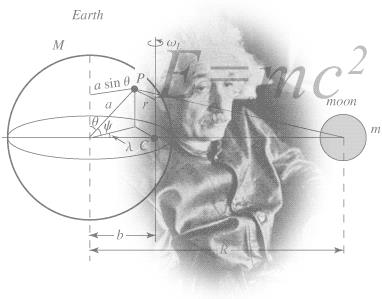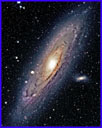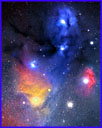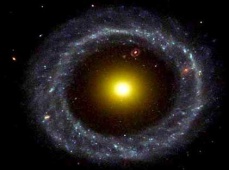
The Hypothesis Theory
of Cosmology

Cosmology is the study of the universe as a whole, including its distant past it’s beyond future. Cosmologist study the universe observationally by looking at the universe and theoretically by using physical laws and theories to predict how the universe should behave. Cosmology is a branch of Astronomy, but the observational and theoretical techniques used by cosmologists involve a wide range of sciences, such as physics and chemistry. Cosmology is did distinguished from cosmology, which used to mean the study of the origin of the universe but now usually refers to the study of the origin of the solar system. History will, no doubt, recognize many of today’s theorist and scientists for their astonishing collective and personal contributions to our future understanding of the universe. Here we will recognize some ... though certainly not all of those whose ideas or discoveries have, over time, shaped human understanding of the stars and beyond with their own forthcoming Hypothesis Theories of the creation of the universe.








Hypothesis; A tentative explanation for a phenomenon, used as a basis for further investigation; a supposition or proposed explanation made on the bases of limited evidence as a starting point for further investigation. (The hypothesis of the big bang is one way to explain the beginning of the universe)
Theory; IN THERORY, EVERYTHING IS POSIBLE. Theory is a company, a concept, an aesthetic, a style and a product. A supposition of a system of ideas intended to explain something esp. One based on published his second major paper on relativity, which altered mankind’s fundamental concepts of space and time. general principles independent of the thing to be explained:
Physicist; A scientist who studies or practices physics. Physicists study a wide range of physical phenomena in many branches of physics spanning all length scales: from sub-atomic particles which all ordinary matter is made (particle physics) to the behavior of the material Universe as a whole (cosmology).
Space; interval of time: a period or interval of time enough room: room to fit or accommodate something or somebody area set apart: an area set apart or available for use – region beyond Earth’s atmosphere: the region that lies beyond the Earth’s atmosphere, and all that it contains- region between all…time- system of distinguishing events: a dimension that enables two identical events occurring at the same point in space to be distinguished, measured by the interval between the events. – Period with limits: a limited period during which an action, process, or shape exists or takes place.
Time; system of distinguishing events: a dimension that enables two identical events occurring at the same point in space to be distinguished, measured by the interval between the events- period with limits: a limited period during which an action, process, or condition exists or takes place
Dimension; in geometry, a property of space. In common experience the world is three-dimensional. Three measures—breath, width, and depth; Extent, Scope, proportions---usually used in plural.
Astronomy; (from the Greek words astro (αστέρι) = star and nomos (νόμος) = law) is the scientific study of celestial objects (such as stars, planets, comets, and galaxies) and phenomena that originate outside the Earth’s atmosphere (such as the cosmic background radiation). It is concerned with the evolution, physics, chemistry, meteorology, and motion of celestial objects, as well as the formation and development of the universe.
Nicola us Copernicus; (February 19, 1473 – May 24, 1543) was the first astronomer to formulate a scientifically based heliocentric cosmology that displaced the Earth from the center of the universe. His epochal book, De revolution us orbium coelestium (On the Revolutions of the Celestial Spheres), is often regarded as the starting point of modern astronomy and the defining epiphany that began the Scientific Revolution.
Galileo Galilei; (1564-1642), Italian physicist and astronomer. One of the founders of Europe’s scientific revolution, his main contributions includes the application of the telescope to astronomy and the discovery of the laws of falling bodies and the motions of projectiles.
Isaac Newton; (1642-1727), English physicist, mathematician, and natural philosopher, considered one of the most important scientists of all time. Among other discoveries, Newton formulated laws of universal gravitation and motion laws that explain how objects move on Earth as well as through the heavens for other uses, see Newton’s laws of motion.
Albert Einstein; (1879-1955), German-born American physicist and Nobel laureate, best known as the creator of the special and general theories of relativity and for his bold hypothesis concerning the particle nature of light. He is perhaps the most well-known scientist of the 20th century. In 1916 he we wouldn’t be here if it weren’t for God’s Time PERIOD! That is why we live in a precise and sustainable world capable of our very existence and yes, as being different by the virtual way we look and think to and from the stone age Neanderthal or Cro-Magnon caveman era of time approximately 200,000 years ago and even back further through the prehistoric dinosaur era roughly 65 million years earlier. Any more than we can perceive and comprehend living in the prehistoric era of time, Whose to question God’s Time and timing of ours, thus the miracle of it all and what is a miracle without God? This alone should be enough to stimulate the brain into understanding that the difference in Time periods is irrelevant to ours when “God is as Time” is.
Steven Hawking; Born in 1942, British theoretical physicist and mathematician whose main field of research has been the nature of space and time, including irregularities in space and time known as singularities. His key scientific works to date have included providing, with Roger Penrose, theorems regarding singularities in the framework of general relativity, and the theoretical prediction that black holes should emit radiation, which is today known as Hawking radiation, or sometimes as Bekenstein-Hawking radiation. His scientific career spans more than 40 years and his books and public appearances have made him an academic celebrity and world-renowned theoretical physicist. He is an Honorary Fellow of the Royal Society of Arts.
Hawking is disabled by amyotrophic lateral sclerosis (ALS), commonly known in the United States as Lou Gehrig’s Disease. The illness has progressed over the years and he is now almost completely paralyzed. His key scientific works to date have included providing, with Roger Penrose, theorems regarding singularities in the framework of general relativity, and the theoretical prediction that black holes should emit radiation, which is today known as the information paradox of General relativity. His main goal was to be able to explain scientifically all things regarding the universe. “The only thing is, he’ll have to have faith in God to relate and equate how he did it”
Creationism; a broad range of beliefs involving an appeal to God’s miraculous intervention to explain the origin of the universe, of life, and of the different kinds of plants and animals on earth. Adherents, called creationists, all invoke divine intervention to explain at least some of these phenomena, although they do not necessarily agree on the length of time involved in creation. In the second half of the 20th century, the most visible and politically active creationists maintained that the entire universe was created within the past 6000 to 10,000 years, but what was considered God’s year? Was it 352 days or was it a thousand times that (1000 x 352 = 352,000) or up. Keep in mind that Methuselah, in the Old Testament, the son of the patriarch Enoch and grandfather of the patriarch Noah. He was said to have died in the year of the deluge at the age of 969 (see Genesis 5:21-27; 1 Chronicles 1:3). Again, what was considered a year in those days? And again, several 100 years after the flood, Moses declared, “the length of our days 70 years”
“It is said that with time nothing can catch up to the speed of light, but is it true with God’s Light? Time is as Eternity is, and Eternity as Time, only if you yourself make no difference between them, as God is of Light and Light is of God and the Light of all that there is, was or ever will be in the cosmology of eternity”.
Ref; of Wikipedia’s encyclopedia; the speed of light (usually denoted c) is a physical constant. Its value is exactly 299,792,458 meters per second, often approximated as 300,000 kilometers per second or 186,000 miles per second). It is the speed of electromagnetic radiation (such as radio waves, visible light, or gamma rays) in vacuum, where there are no atoms, molecules or other types of matter that can slow it down.
Nothing travels faster than the light. Yet, the time as we know it, second by second - minute by minute - hour by hour - day by day - week by week - month by month - year by year - decade by decade - century by century etc.; Accordingly, in a split second at 186,000 miles per second, time travels beyond our existence as we know it – in perspective, a bullet travels at 4,000 feet per second.
The finite speed of light is important in astronomy. Due to the vast distances involved, it can take a very long time for light to travel from its source to Earth. For example, it has taken 13 billion (13 × 109) years for light to travel to Earth from the faraway galaxies viewed in the Hubble Ultra Deep Field images. Those photographs, taken today, capture images of the galaxies as they appeared 13 billion years ago, when the universe was less than a billion years old. The fact that farther-away objects appear younger (due to the finite speed of light) allows astronomers to infer the evolution of stars, of galaxies, and of the universe itself - Something that our tiny minds can’t even expand upon let alone try to fathom in real time.
Take into account that, ... God is as Time - as Time is as God - as the Light is of his Time. In other words, Charles Lyell; (1797-1875), Scottish geologist, whose writings strongly influenced the development of modern geology. Lyell was born in Kinnordy (now Angus), and educated at the University of Oxford. He studied law and was admitted to the bar, but soon afterward devoted himself almost entirely to science, particularly geology. Building on the pioneering work of the 18th-century Scottish geologist James Hutton, Lyell developed the theory of uniformitarianism. This theory says that the natural processes that change the earth in the present have operated in the past at the same gradual rate. Lyell supported his theory with geological observations that he made in the course of extensive travels in Europe and North America. Uniformitarianism contradicted the theory of catastrophism, which was popular among scientists of Lyell’s time.
Catastrophist claimed that only major catastrophes could change the basic formation of the earth, and that the earth was only about 6000 years old. Most scientists believed that catastrophism was consistent with the Bible’s account of the earth’s creation.
Louis Agassiz; (1807-1873), Swiss-American naturalist, one of the best informed and most capable biologists of his day, with an ability to awaken the public’s interest in natural science. Born in Môtiers, Switzerland, Agassiz was educated at the universities of Zürich, Heidelberg, Erlangen, and Munich. In 1826 he prepared a description of Brazilian fish from materials collected by the Bavarian naturalist Johann Baptist von Spix. The work attracted the notice of the French naturalist Georges Cuvier, with whom Agassiz later studied in Paris. From 1832 to 1846 Agassiz was professor of natural history at the University of Neuchâtel. During this time he prepared and published Researches on Fossil Fishes (1833-1844) and Studies on Glaciers (1840). As a result of his observations in the Swiss Alps, he introduced the theory that at one time most of the earth was covered by glaciers (see Ice Ages).
In 1846 Agassiz delivered a course of lectures at Lowell Institute in Boston, Massachusetts, which resulted in his appointment in 1848 as professor of natural history in the Lawrence Scientific School of Harvard University. He held this position for the rest of his life, and he also founded the Museum of Comparative Zoology at Harvard. Agassiz believed in a theory of epochs of creation.
This theory held that earth’s organisms tend to become more complex and better suited to their environment over time through a series of independent acts of creation by a Supreme Being. Agassiz’s theory opposed the mechanisms outlined by Charles Darwin in his theory of evolution. Agassiz explored North America, including the Lake Superior region (1848) and the Florida coral reefs (1850-1851). From 1865 to 1866 he traveled in Brazil; the results of his research there were published in A Journey in Brazil (1868). In 1872 he made a journey to California around Cape Horn. The following year he established a summer school of zoology on Penikese Island, Buzzards Bay, Massachusetts. the shape of future discoveries in cosmology, biology, and related sciences, and Ross wants his model to be judged alongside other models in its predictive success.
Genesis; book of the Old Testament. The English title is derived from the words Genesis kosmou (Greek, “origin of the cosmos”), the title of the book in the Septuagint. The Jews, who know each of the five books comprising the Pentateuch by either the opening word or the first significant word of the Hebrew text, entitle it Bereshith (or Bereshit), “In the beginning.” Genesis, the first book of the Bible, tells of the beginning of the world from the time when “God created the heaven and the earth” (1:1) until the death of Joseph, the 11th son of the Hebrew patriarch Jacob. The book falls into two unequal parts. The first part (chapters 1-11) is concerned with the primeval history of humankind and contains stories about the first man and the first woman, their disobedience, the first murderer and his victim, the flood that God sent to destroy all things save the immediate family of one “just man” (6:9) and the creatures committed to him for preservation, and the confounding of the speech and scattering abroad of later people. The first part of Genesis also contains the first covenant made by God with humanity in the person of Noah (9:9-17).
The second part (chapters 12-50) is mainly an account of the lives of the Hebrew patriarchs Abraham, Isaac, and Jacob, that is, a history of the origins of the Hebrew nation (see Hebrews; Jews). The basic aim of Genesis is to relate all of creation and history to God, and, specifically, to explain the role of Israel in the world. Thus, for example, the genealogies in the first part of the book (chapters 5 and 10, and chapter 11:10-32) connect Adam with Abraham and recount the number of years between the two; formation of the universe, earth, and life itself that accounts for both scientific and religious (particularly Christian) explanations for each. The model he proposes makes certain predictions about the shape of future discoveries in cosmology, biology, and related sciences, and Ross wants his model to be judged alongside other models in its predictive success. He has not published this model in peer-reviewed scientific literature, but he outlines the basic components of the model and provides associated prediction for future scientific research in his book Origins of life (2005).
Index fossils of the first half of the Paleozoic Era are those of invertebrates, such as trilobites, graptolites, and crinoids. Remains of plants and such vertebrates as fish and reptiles make up the index fossils of the second half of this era. The earliest evidence of life consists of microscopic fossils of bacteria that lived as early as 3.8 billion years ago. Most Precambrian fossils are very tiny.
Most species of larger animals that lived in later Precambrian time had soft bodies, without shells or other hard body parts that would create lasting fossils. The first abundant fossils of larger animals date from about 600 million years ago.
Cambrian Period; at the beginning of the Cambrian Period (542 million to 488 million years ago) animal life was entirely confined to the seas. By the end of the period, all the modern phyla of the animal kingdom existed. The characteristic animals of the Cambrian Period were the trilobites, a primitive form of arthropod, which reached their fullest development in this period and became extinct by the end of the Paleozoic Era. The earliest snails appeared in this period, as did the cephalopod mollusks. Other groups represented in the Cambrian Period were brachiopods, bryozoans, and foraminifers (see Foraminifera). Plants of the Cambrian Period consisted of algae in the oceans.
Hugh Ross (creationist) Hugh Norman Ross (born July 24, 1945) is a Canadian-born Old Earth creationist and Christian apologist. An astronomer and astrophysicist by training, he has established his own ministry called Reasons To Believe that promotes a form of Old Earth creationism known as progressive creationism. Ross accepts the scientific evidence of the age of the earth and the age of the universe, but he rejects evolution and abiogenesis as explanations for the history and origin of life.
Biography: Ross was born in Montreal and raised in Vancouver, Canada. He earned a BSc in physics from the University of British Columbia and an MSc and PhD in astronomy from the University of Toronto; and he was a postdoctoral research fellow at Caltech, studying quasars and galaxies. Ross was the youngest person ever to serve as director of observations for Vancouver’s Royal Astronomical Society, and before starting Reasons to Believe, he was on the staff of Sierra Madre Congregational Church.
In addition to apologetics writing, Ross speaks regularly in academic venues and churches, as well as Ross’ overall philosophy is that science and religion are not only compatible but complementary and, with Thomas Torrance, that the scientific method itself springs from the Reformation and the Bible. He adopts the view that there are two “books” of revelation from God – the Bible and nature – which both offer accurate knowledge and each of which can correct misunderstanding of the other. Moreover, he argues that the Bible is the only scientifically accurate religious text when interpreted consistently. Ross and his associates are formally engaged in proposing an alternate, scientifically testable model for the sometimes called the law of upkeep of energy. sometimes called the law of
This principle derives from the study of the physical properties of energy, and therefore, states the condition of energy as it is understood in our physical world. It is an established scientific law because there are no known experimental exceptions to suggest that energy can be created or destroyed.
It has been studied and analyzed by thousands of scientists for over two hundred years. Observation shows that the universe exists in many forms of energy, such as matter, light, and heat, but there are no known physical conditions whereby energy can be or is created. The obvious question often asked is, "Where did this energy come from?"
Ross instead asserts that these days (translated from the Hebrew word yom) are historic, distinct, and sequential, but not literally 24 hours in length nor equal in length. He agrees with the scientific community at large that the vast majority of YEC arguments are pseudoscience, and finds any version of intelligent design inadequate that doesn’t provide a testable hypothesis which can make verifiable and falsifiable predictions. Ross is criticized by YECs for his acceptance of uniformitarian geology and astronomy over what they see as a plain reading of Genesis and for promoting “fixity of species”, which denies speciation.
YECs use speciation to explain how present biodiversity could have arisen from the small number of "kinds" after Noah's Flood. Ross holds that Noah's Flood was local yet believes it killed all humans except for those on the ark, whereas YECs generally hold that Noah's Flood was global. He and his team have also said that intelligent design is not science and agree that it should not be taught as science in the class room. Some of Ross' ideas – particularly his criticism of evolution – are faulted by the scientific community as being little different from YEC, but Ross states his work provides a better fit for the data than either the YEC or the conventional models.
Evidence for the Supernatural Creation of the Universe Patrick R. Briney, Ph.D.
The first law of thermodynamics states that energy is not created or destroyed. It can be changed into different forms, but there is no gain or loss of energy. Thus, the first law of thermodynamics is some evolutionists defend the evolution model for the universe arguing that an undiscovered law exists to explain the origin of energy by natural means.
In other words, they believe that evolution is a legitimate model of science because of the hope for finding an unknown law. In some cases, models persist with this anticipation. But, never has a model been considered legitimate when it contradicted known evidence and much less a law.
This is a desperate attempt to excuse not only the lack of evidence but to defend a conclusion that contradicts a known scientific law. This is not good science. The creation science model for the origin of the universe rests firmly on a known, demonstrable law of science.
According to the first law of thermodynamics, the physical properties of the universe cannot create energy. Yet energy exists.
Accepting that the first law of thermodynamics is the empirically derived conclusion that energy is conserved and establishes the inability of physical properties to create more energy, the logical deduction is that the origin of the universe is best explained by means of supernatural creation. The physical properties of matter are not capable of producing more energy.
The creation science model conforms to the scientific data, explains the evidence, and does not contradict the scientific law. I like to sum the conclusion in four points.
Some object that concluding a supernatural origin of energy is unscientific. They justify this criticism by saying that the supernatural cannot be tested. But this objection fails to acknowledge that it is the scientific observations and method that lead to this conclusion. Confusion about the scientific conclusion for the supernatural origin of energy is resolved by recognizing the difference between being able to determine the mechanism of how energy was created, from being able to determine that energy was created supernaturally. We do not have to how something happened in order to know that it did happen.
The persistence of such an irrational conclusion is due solely because of stubborn adherence to a faulty belief system. The creation model rests on solid, known scientific data, whereas the evolution model rests on an irrational belief in spite of its contradiction to a known scientific law. The following four points show the problem with a natural explanation for the origin of the universe.
The following four point argument summarizes how evolution contradicts the first law of thermodynamics. 1. Evolution proposes strictly natural (physical) explanations. 2. The natural explanation for the origin of energy contradicts a natural law. 3. Explanations that contradict laws of science are unscientific. 4. Therefore, evolution as an explanation for the origin of energy is unscientific. usable and organized state. 3. If the initial usable energy in the universe was not increased by natural means, then it must have originated supernaturally. 4. The creation model conforms to the data.
In contrast to the creation science model, evolution proposes that the low entropy state of the universe originated by natural means. This model contradicts a known scientific law which states that there is no natural means whereby entropy can be decreased in a closed system. Any model that contradicts a scientific law is clearly not a credible model.
The persistence of such an irrational conclusion is due solely because of stubborn adherence to a faulty belief system. The creation model rests on solid, known scientific data, whereas the evolution model rests on an irrational belief in spite of its contradiction to a known scientific law. The following four points show the problem with a natural explanation for the origin of the universe.
In contrast to the creation science model, evolution proposes that the low entropy state of the universe originated by natural means. This model contradicts a known scientific law which states that there is no natural means whereby entropy can be decreased in a closed system. Any model that contradicts a scientific law is clearly not a credible model.
The persistence of such an irrational conclusion is due solely because of stubborn adherence to a faulty belief system. The creation model rests on solid, known scientific data, whereas the evolution model rests on an irrational belief in spite of its contradiction to a known scientific law. The following four points show the problem with a natural explanation for the origin of the universe.
The Evolution model rests on excuses for the absence of evidence and in contradiction to a known law. Second Law of Thermodynamics To avoid the obvious contradiction with the first law of thermodynamics, some evolutionists contend that energy was not created. They say it always existed.
However, the second law of thermodynamics prevents this from being a valid explanation. It states that there is no natural means to increase the net usable energy in a closed (isolated) system. In other words, the net flow of energy in any closed system ultimately tends to entropy (disorder, chaos).
Entropy is energy in its lowest state and, subsequently, unusable form. It is sometimes described as the disorder or chaos of a system. A closed system refers to the absence of external influences to increase usable energy or to reverse entropy. For example, if a clock is placed inside of a sealed container to prevent someone from winding it up again, the clock can be described as being in a closed system.
When the spring inside the clock winds down, there is no more usable energy available to the clock to make it continue ticking. As long as the clock remains in a closed system, it will not tick again. However, if the clock system is opened, and someone winds the clock up, then the clock can begin to tick again.
#1 There is no natural means to increase the net usable energy in a closed system such as the universe. 2. The universe is decreasing in usable energy meaning that its initial energy existed in a greater
#1 Evolution proposes that the entropy was reduced in the universe by physical properties in the universe. 2. Proposing that entropy was reduced in the universe by physical properties in the universe contradicts the second law of thermodynamics. 3. Explanations that contradict data are unscientific. 4. Therefore, evolution as an explanation for the origin of reduced entropy in the universe is unscientific.
In light of the first and second laws of thermodynamics, the best explanation for the origin of the universe is the Creation science model. It explains the known data, is supported by known data, and does not contradict laws of science. This is good science and good scientific modeling.
Concerning models offered in conflict with the second law of thermodynamics, British astronomer Arthur Eddington said, “If your theory is found to be against the second law of thermodynamics I can give you no hope; there is nothing for it but to collapse in deepest humiliation.” (Arthur S. Eddington, The Nature of the Physical World (Macmillan, 1930, p. 74).
Gordon Van Wylen, Chairman of the Dept. of Mechanical Engineering at the University of Michigan commented that, “The question that arises is how the universe got into the state of reduced entropy in the first place, since all natural processes known to us tend to increase entropy?” (Gordon Van Wylen and Richard Edwin Sonntag, Fundamentals of Classical Thermodynamics, 1973). He concludes by saying, “The author has found that the second law [of thermodynamics] tends to increase conviction that there is a Creator.
Ref; essays of (The Science of Gods Earth), (The Analytic Miracle), (The Earth Moon System), (The Anatomy of the Sun), (The Astronomy of Gods Cosmos), (Photosynthesis in Peril), (Relevance of Time), (The treasures of Today), (The Origin between Good and Evil), (Atom of Adam Evolutions Theory), (The Singularity Theorem of Evolution) (The Human Body), (The Human Brain), (Religions 4W’s), (Religions of convenience), (The Meaning of Christmas), and most of all the main essay of (The Human Heart).
In conclusion, this essay is more about common sense of thinking rather than that of the science of creation. My writings are more lined up with Hugh Ross’s writings with his overall philosophy being that science and religion are not only compatible but complementary with one another and with Thomas Torrance, that the scientific method itself springs from the Reformation and the Bible. For the purpose of verifiable accountability, each and every-one of my essay-writings is lined up in order from the beginning to the end, as meant to be. The reason is to hopefully reach those wh Can and want to reason from a rational stand point of view. Those who defend what is right Over wrong thinking for the good of humanities sake and aren’t ashamed to display it. A progressive-unprejudiced-mind will lead to self-awareness, self-explanation,
Self-assurance, self-satisfaction, self-fulfillment, self-worth, self-esteem, self-respect, self-possession, self-confidence, and most of all the Self-gratification for the integrity of the truth and beyond. “If you won’t evaluate, you can’t assimilate” “if can’t comprehend, you will never understand “Knowledge is Everything and everything is knowledge” Albert Einstein; “We can’t solve problems by using the same kind of thinking we used when we created them".
Written and Designed by,
Don L. Johnson
